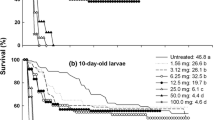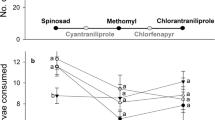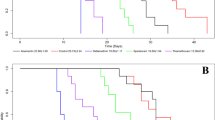Abstract
The endoparasitoid wasp Cotesia flavipes (Cameron) (Hymenoptera: Braconidae) is inundatively released in Brazilian sugarcane plantations to control the sugarcane borers Diatraea saccharalis (Fabricius) and Diatraea flavipennella (Box) (Lepidoptera: Crambidae). In conjunction with these releases, several synthetic insecticides are used to control the neonate larvae of these pests. We assessed the lethal and transgenerational sublethal effects of seven of these insecticides on C. flavipes. Leaf discs were sprayed at the highest field concentrations of chlorantraniliprole, lambda-cyhalothrin + chlorantraniliprole, chlorfluazuron, triflumuron, lambda-cyhalothrin + thiamethoxam, tebufenozide, and novaluron. Distilled water was used as a negative control. Newly emerged females (24 h old) were placed in Petri dishes containing the treated leaves, and the lethal and transgenerational sublethal effects were assessed for the next two generations. Lambda-cyhalothrin + chlorantraniliprole and lambda-cyhalothrin + thiamethoxam caused 100% mortality of the parasitoid and were highly persistent, causing more than 30% mortality at 30 days after spraying. Chlorantraniliprole, chlorfluazuron, novaluron, and triflumuron did not cause significant mortality compared to the negative control, but did have transgenerational sublethal effects. The length of the tibia of the right posterior leg, used as a growth measurement, was reduced in the progeny (F1 generation) of exposed female parasitoids. In addition, chlorantraniliprole increased and chlorfluazuron reduced the proportion of females in the F1 generation, whereas novaluron reduced the proportion of females in the F2 generation. Overall, only tebufenozide was considered harmless to C. flavipes. The results of this study suggest that lambda-cyhalothrin + chlorantraniliprole and lambda-cyhalothrin + thiamethoxam are harmful to C. flavipes, although field studies are needed to obtain results for actual sugarcane crops.

Similar content being viewed by others
References
Amarasekare KG, Shearer PW, Mills NJ (2016) Testing the selectivity of pesticide effects on natural enemies in laboratory bioassays. Biol Control 102:7–16
Araújo JR, Botelho PSM, Araújo SMSS, Almeida LC, Degaspari N (1985) Nova dieta artificial para criação da Diatraea saccharalis (Fabr.). Saccharum Apc Rev Tecnol Ind Açúcar Álcool 36:45–48
Bates D, Mächler M, Bolker B, Walker S (2015) Fitting linear mixed-effects models using lme4. J Stat Softw 67:1–48
Beloti VH, Alves GR, Moral RA, Demétrio CGB, Yamamoto PT (2018) The toxicity of fresh and aged residues of pesticides to the parasitoid Tamarixia radiata and to the HLB-bacteria vector Diaphorina citri. Neotrop Entomol 47:403–411
Bengochea P, Christiaens O, Amor F et al. (2012) Ecdysteroid receptor docking suggests that dibenzoylhydrazine-based insecticides are devoid of any deleterious effect on the parasitic wasp Psyttalia concolor (Hym. Braconidae). Pest Manag Sci 68:976–985
Biddinger DJ, Leslie TW, Joshi NK (2014) Reduced-risk pest management programs for Eastern US peach orchards: effects on arthropod predators, parasitoids, and select pests. J Econ Entomol 107:1084–1091
Biondi A, Campolo O, Desneux N, Siscaro G, Palmeri V, Zappala L (2015) Life stage-dependent susceptibility of Aphytis melinus DeBach (Hymenoptera: Aphelinidae) to two pesticides commonly used in citrus orchards. Chemosphere 128:142–147
Biondi A, Desneux N, Siscaro G, Zappalà L (2012) Using organic-certified rather than synthetic pesticides may not be safer for biological control agents: selectivity and side effects of 14 pesticides on the predator Orius laevigatus. Chemosphere 87:803–812
Cabrera P, Cormier D, Lucas E (2018) Sublethal effects of two reduced-risk insecticides: when the invasive ladybeetle is drastically affected, whereas the indigenous not. J Pest Sci 91:1153–1164
Castro AA, Lacerda MC, Zanuncio TV, Ramalho FS, Polanczyk RA, Serrão JE, Zanuncio JC (2012) Effect of the insect growth regulator diflubenzuron on the predator Podisus nigrispinus (Heteroptera: Pentatomidae). Ecotoxicology 21:96–103
Chen X, Ma K, Li F, Liang P, Liu Y, Guo T, Song D, Desneux N, Xiwu G (2016) Sublethal and transgenerational effects of sulfoxaflor on the biological traits of the cotton aphid, Aphis gossypii Glover (Hemiptera: Aphididae). Ecotoxicology 25:1841–1848
Conab (2018) Companhia Nacional de Abastecimento. Levantamento de safra da cana-de-açúcar. https://www.conab.gov.br/info-agro/safras/cana. Accessed 23 Jan 2019
Cordova D, Benner EA, Sacher MD, Rauh JJ, Sopa JS, Lahm GP, Selby TP, Stevenson TM, Flexner L, Gutteridge S, Rhoades DF, Wu L, Smith RM, Tao Y (2006) Anthranilic diamides: a new class of insecticides with a novel mode of action, ryanodine receptor activation. Pestic Biochem Physiol 84:196–214
Costa MA, Moscardini VF, Gontijo P, da C, Carvalho GA, Oliveira RL, Oliveira HN (2014) Sublethal and transgenerational effects of insecticides in developing Trichogramma galloi (Hymenoptera: Trichogrammatidae). Ecotoxicology 23:1399–1408
Demétrio CGB, Hinde J, Moral RA (2014) Models for overdispersed data in entomology. In: Ferreira CP, Godoy WAC (eds) Ecological modeling applied to entomology. Springer, Cham, pp 219–259
Desneux N, Decourtye A, Delpuech JM (2007) The Sublethal effects of pesticides on beneficial arthropods. Annu Rev Entomol 52:81–106
Dinardo-Miranda LL (2008) Pragas. In: Dinardo-Miranda LL, Vasconcelos ACM, Landell MGA (eds) Cana-de-açúcar. Instituto Agronômico, Campinas, pp 349–404
Dinardo-Miranda LL, Fracasso JV, Costa VP, da, Lopes DOT (2014) Dispersal of Cotesia flavipes in sugarcane field and implications for parasitoid releases. Bragantia 73:163–170
Ebbinghaus-Kintscher U, Raming K, Masaki T, Yasokawa N (2007) Flubendiamide, the first insecticide with a novel mode of action on insect ryanodine receptors. Pflanzenschutz Nachr Bayer 60:117–140
Fonseca APP, Marques EJ, Torres JB, Silva LM, Siqueira HAA (2015) Lethal and sublethal effects of lufenuron on sugarcane borer Diatraea flavipennella and its parasitoid Cotesia flavipes. Ecotoxicology 24:1869–1879
Gradish AE, Scott-Dupree CD, Shipp L, Ron-Harris C, Ferguson G (2011) Effect of reduced risk pesticides on greenhouse vegetable arthropod biological control agents. Pest Manag Sci 67:82–86
Goulart RM, Volpe HXL, Vacari AM, Thuler RT, Bortoli SA (2012) Insecticide selectivity to two species of Trichogramma in three different hosts, as determined by IOBC/WPRS methodology. Pest Manag Sci 68:240–244
Guedes RNC, Smagghe G, Stark JD, Desneux N (2016) Pesticide-induced stress in arthropod pests for optimized integrated pest management programs. Annu Rev Entomol 61:43–62
Haseeb M, Amano H (2002) Effects of contact, oral and persistent toxicity of selected pesticides on Cotesia plutellae (Hym., Braconidae), a potential parasitoid of Plutella xylostella (Lep., Plutellidae). J Appl Entomol 126:8–13
Haseeb M, Liu TX, Jones WA (2004) Effects of selected insecticides on Cotesia plutellae, endoparasitoid of Plutella xylostella. BioControl 49:33–46
Hassan SA (1994) Activities of the IOBC/WPRS Working Group “Pesticides and Beneficial Organisms”. IOBC/WPRS Bull 17:1–5
Hedayati M, Sadeghi A, Maroufpoor M, Ghobari H, Güncan A (2019) Transgenerational sublethal effects of abamectin and pyridaben on demographic traits of Phytonemus pallidus (Banks) (Acari: Tarsonemidae). Ecotoxicology 28:467–477
Hensley SD, Hammond Jr AM (1968) Laboratory technique for rearing the sugarcane borer on an artificial diet. J Econ Entomol 61:1742–1743
Hothorn T, Bretz F, Westfall P (2008) Simultaneous inference in general parametric models. Biom J 50:346–363
Huang J, Wu S, Ye G (2011) Evaluation of lethal effects of chlorantraniliprole on Chilo suppressalis and its larval parasitoid, Cotesia chilonis. Agric Sci China 10:1134–1138
Idris AB, Grafius E (1993) Field studies on the impact of pesticides on the diamondback moth, Plutella xylostella (L.) (Lepidoptera: Plutellidae) and parasitism by Diadegma insulare (Cresson) (Hymenoptera: Ichneumonidae). J Econ Entomol 86:1196–1202
IRAC (2019) Insecticide Resistance Action Committee IRAC. Mode of Action Classification Scheme. IRAC Int. MoA Work Gr. Version 9.3:1–30. https://www.irac-online.org/modes-of-action/
Jam NA, Saber M (2018) Sublethal effects of imidacloprid and pymetrozine on the functional response of the aphid parasitoid, Lysiphlebus fabarum. Entomol Gen 38:173–190
Jia H, Shun-Fan W, Gong-Yin Y (2011) Evaluation of lethal effects of chlorantraniliprole on Chilo suppressalis and its larval parasitoid, Cotesia chilonis. Agr Sci China 10:1134–1138
Joyce AL, White WH, Medina RF (2014) Host plants impact courtship vibration transmission and mating success of a parasitoid wasp, Cotesia flavipes (Hymenoptera: Braconidae). Evol Ecol 28:361–372
King BH (2000) Sex ratio and oviposition responses to host age and the fitness consequences to mother and offspring in the parasitoid wasp Spalangia endius. Behav Ecol Sociobiol 48:316–320
Kishore MN, Krishnamoorthy SV, Kuttalam S (2014) Safety of chlorantraniliprole 18.5 SC to Cotesia plutellae (Kurudjumov) a larval endoparasitoid of Plutella xylostella L. J. Res. Angrau 42:4–8
Lin YW, Wu G, Miyata T (2007) Insecticide susceptibility of surviving Cotesia plutellae (Hym: Braconidae) and Diaeretiella rapae (M’Intosh) (Hym: Aphidiidae) as affected by sublethal insecticide dosages on host insects. Pest Manag Sci 63:841–850
Mahmoud AMA, Luna-Santillana D, Rodriguez-Perez MA (2011) Parasitism by the endoparasitoid, Cotesia flavipes induces cellular immunosuppression and enhances susceptibility of the sugar cane borer, Diatraea saccharalis to Bacillus thuringiensis. J Insect Sci 11:1–15
MAPA (2019) Ministério da Agricultura, Pecuária e Abastecimento AGROFIT: Sistema de Agrotóxicos Fitossanitários. MAPA/CGAF/DFIA/DAS, Brasília, Brazil. http://www.extranet.agricultura.gov.br/agrofit_cons/principal_agrofit_cons. Accessed 12 Jan 2019
Mardani A, Sabahi Q, Almasi A (2016) Susceptibility of pupal and adult stages of the parasitoid Lysiphlebus fabarum Marshall (Hym.: Braconidae) to insecticides thiacloprid + deltamethrin, pirimicarb and pymetrozine. Plant Pest Res 6:61–71
Margus A, Piiroinen S, Lehmann P, Tikka S, Karvanen J, Lindström L (2019) Sublethal pyrethroid insecticide exposure carries positive fitness effects over generations in a pest insect. Sci Rep 9:1–10
Menn JJ, Beroza M (1972) Insect juvenile hormones, chemistry and action. Academic Press, New York, NY
Molnár S, López I, Gámez M, Garay J (2016) A two-agent model applied to the biological control of the sugarcane borer (Diatraea saccharalis) by the egg parasitoid Trichogramma galloi and the larvae parasitoid Cotesia flavipes. Biosystems 141:45–54
Momanyi G, Maranga R, Sithanantham S, Agong S, Matoka CM, Hassan SA (2012) Evaluation of persistence and relative toxicity of some pest control products to adults of two native trichogrammatid species in Kenya. BioControl 57:591–601
Muslim M, Ansari MS, Hasan F (2018) Non-target toxicity of synthetic insecticides on the biological performance and population growth of Bracon hebetor Say. Ecotoxicology 27:1019–1031
Nelder JA, Wedderburn RWM (1972) Generalized linear models. J R Stat Soc 135:370–384
Ohta I, Takeda M (2015) Acute toxicities of 42 pesticides used for green peppers to an aphid parasitoid, Aphidius gifuensis (Hymenoptera: Braconidae), in adult and mummy stages. Appl Entomol Zool 50:207–212
Oliveira CM, Auad AM, Mendes SM, Frizzas MR (2014) Crop losses and the economic impact of insect pests on Brazilian agriculture. Crop Prot 56:50–54
Paiva ACR, Beloti VH, Yamamoto PT (2018) Sublethal effects of insecticides used in soybean on the parasitoid Trichogramma pretiosum. Ecotoxicology 27:448–456
Parra JRP (2014) Biological control in Brazil: an overview. Sci Agric 71:420–429
Parra JRP, Botelho PSM, Pinto AS (2014). Biological control of pests as a key component for sustainable sugarcane production. In: Cortez LAB (Coord.) Sugarcane bioethanol—R&D for productivity and sustainability. Edgard Blücher, São Paulo, p 441–450
Passos EM, Wanderley-Teixeira V, Marques EJ, Teixeira ÁAC, Brayner FA (2014) Cotesia flavipes (CAM) (Hymenoptera: Braconidae) supresses immune responses in Diatraea flavipennella (BOX) (Lepidoptera: Crambidae). Acad Bras Ciênc 86:2013–2024
Passos LC, Soares MA, Collares LJ, Malagoli I, Desneux N, Carvalho GA (2018) Lethal, sublethal and transgenerational effects of insecticides on Macrolophus basicornis, predator of Tuta absoluta. Entomol Gen 38:127–143
Pavinato VAC, Michel AP, Campos JB, Omoto C, Zucchi MI (2018) Influence of historical land use and modern agricultural expansion on the spatial and ecological divergence of sugarcane borer, Diatraea saccharalis (Lepidoptera: Crambidae) in Brazil. Heredity 120:25–37
Pazini JB, Pasini R, Seidel E, Rakes M, Martins JFS, Grützmacher AD (2017) Side-effects of pesticides used in irrigated rice areas on Telenomus podisi Ashmead (Hymenoptera: Platygastridae). Ecotoxicology 26:782–791
Perez-Farinos G, Smagghe G, Marco V, Tirry L, Castañera P (1998) Effects of topical application of hexaflumuron on adult sugar beet weevil, Aubeonymus mariaefranciscae, on embryonic development: pharmacokinetics in adults and embryos. Pestic Biochem Physiol 61:169–182
Pinto AS, Garcia JF, Botelho BSM (2006) Controle biológico na cana-de-açúcar. In: Pinto AS, Nava DE, Rossi MM, Malerbo-Souza DT (eds) Controle biológico de pragas na prática. Embrapa (Alice), Piracicaba, pp 65–74
Prabhaker N, Castle SJ, Naranjo SE, Toscano NC, Morse JG (2011) Compatibility of two systemic neonicotinoids, imidacloprid and thiamethoxam, with various natural enemies of agricultural pests. J Econ Entomol 104:773–781
Querino RB, Zucchi RA (2011) Guia de identificação de Trichogramma para o Brasil. Embrapa Informação Tecnológica, Brasília
R Development Core Team (2018). R: a language and environment for statistical computing. R Foundation for Statistical Computing, Vienna
Riddick EW (2006) Egg load and body size of lab-cultured Cotesia marginiventris. BioControl 51:603–610
Rossi GD, Salvador G, Cônsoli FL (2014) The parasitoid, Cotesia flavipes (Cameron) (Hymenoptera: Braconidae), influences food consumption and utilization by larval Diatraea saccharalis (F.) (Lepidoptera: Crambidae). Arch Insect Biochem Physiol 87:85–94
Santos RF, Vacari AM, Bortoli SA, Bortoli CP, Santos JA (2015) Development of a new container for storage and release of the parasitoid Cotesia flavipes (Hymenoptera: Braconidae). J Econ Entomol 108:969–974
Schneider MI, Smagghe G, Gobbi A, Viñuela E (2003) Toxicity and pharmacokinetics of insect growth regulators and other novel insecticides on pupae of Hyposoter didymator (Hymenoptera: Ichneumonidae), a parasitoid of early larval instars of lepidopteran pests. J Econ Entomol 96:1054–1065
Sétamou M, Bernal JS, Legaspi JC, Mirkov TE (2002) Effects of snowdrop lectin (Galanthus nivalis Agglutinin) expressed in transgenic sugarcane on fitness of Cotesia flavipes (Hymenoptera: Braconidae), a parasitoid of the nontarget pest Diatraea saccharalis (Lepidoptera: Crambidae). Ann Entomol Soc Am 95:75–83
Shi ZH, Guo SJ, Lin WC, Liu SS (2004) Evaluation of selective toxicity of five pesticides against Plutella xylostella (Lep: Plutellidae) and their side-effects against Cotesia plutellae (Hym: Braconidae) and Oomyzus sokolowskii (Hym: Eulophidae). Pest Manag Sci 60:1213–1219
Silva-Torres CSA, Ramos-Filho IT, Torres JB, Barros R (2009) Superparasitism and host size effects in Oomyzus sokolowskii, a parasitoid of diamondback moth. Entomol Exp Appl 133:65–73
Soares MA, Passos LC, Campos MR, Collares LJ, Desneux N, Carvalho GA (2019) Side effects of insecticides commonly used against Tuta absoluta on the predator Macrolophus basicornis. J Pest Sci 92:1447–1456
Soderlund DM, Bloomquist JR (1989) Neurotoxic Actions of Pyrethroid Insecticides. Annu Rev Entomol 34:77–96
Soler R, Bezemer TM, Cortesero AM, Van der Putten WH, Vet LEM, Harvey JA (2007) Impact of foliar herbivory on the development of a root-feeding insect and its parasitoid. Plant Anim Interact 152:257–264
Staal GB (1975) Insect growth regulators with juvenile hormone activity. Ann Rev Entomol 20:417–460
Stecca CS, Pasini A, Bueno AF, Denez MD, Silva DM, Mantovani MAM (2014) Insecticide selectivity for Doru lineare (Dermaptera: Forficulidae). Rev Bras Milho Sorgo 13:107–115
Sun R, Liu C, Zhang H, Wang Q (2015) Benzoylurea chitin synthesis inhibitors. J Agric Food Chem 63:6847–6865
Tabozada EK, El-Arnaouty SA, Sayed SM (2014) Effectiveness of two chitin synthesis inhibitors; lufenoxuron and lufenuron on Spodoptera littoralis (Lepidoptera: Noctuidae) and side effects of sublethal concentrations of them on two hymenopteran parasitoids. Life Sci J 11:239–245
Tomizawa M, Casida JE (2005) Neonicotinoid insecticide toxicology: mechanisms of selective action. Annu Rev Pharmacol Toxicol 45:247–268
Trevisan M, De Bortoli SA, Vacari AM, Laurentis VL, Ramalho DG (2016) Quality of the exotic parasitoid Cotesia flavipes (Hymenoptera: Braconidae) does not show deleterious effects after inbreeding for 10 generations. PLoS ONE 11:e0160898
Tunaz H, Uygun N (2004) Insect growth regulators for insect pest control. Turk J Agric 28:377–387
Vacari AM, Genovez GS, Laurentis VL, De Bortoli SA (2012) Fonte proteica na criação de Diatraea saccharalis e seu reflexo na produção e no controle de qualidade de Cotesia flavipes. Bragantia 71:355–361
Van Leerdam MB, Smith JW, Fuchs TW (1985) Frass-mediated, host-finding behavior of Cotesia flavipes, a braconid parasite of Diatraea saccharalis (Lepidoptera: Pyralidae). Ann Entomol Soc Am 78:647–650
Vilela EF, Fernandes JB, Parra JRP, Moscardi F, Rabinovitch L (1998) Controle biológico e feromônios de insetos no âmbito do agronegócio. UFV, Viçosa, p 74
Wang S, Qi Y, Desneux N, Shi X, Biondi A, Gao X (2017a) Sublethal and transgenerational effects of short-term and chronic exposures to the neonicotinoid nitenpyram on the cotton aphid Aphis gossypii. J Pest Sci 90:389–396
Wang Y, Xu F, Yu G, Shi J, Li C, Dai A, Liu Z, Xu J, Wang F, Wu J (2017b) Synthesis and insecticidal activity of diacylhydrazine derivatives containing a 3-bromo-1-(3-chloropyridin-2-yl)-1H-pyrazole scaffold. Chem Cent J 11:50
Wiedenmann RN, Smith JW, Darnell PO (1992) Laboratory rearing and biology of the parasite Cotesia flavipes (Hymenoptera: Braconidae) using Diatraea saccharalis (Lepidoptera: Pyralidae) as a host. Environ Entomol 21:1160–1167
Wiesner P, Kayser H (2000) Characterization of nicotinic acetylcholine receptors from the insects Aphis craccivora, Myzus persicae, and Locusta migratoria by radioligand binding assays: relation to thiamethoxam action. J Biochem Mol Toxicol 14:221–230
Yao F, Zheng Y, Zhao J, Desneux N, Hea YX, Wenga QY (2015) Lethal and sublethal effects of thiamethoxam on the whitefly predator Serangium japonicum (Coleoptera: Coccinellidae) through different exposure routes. Chemosphere 128:49–55
Acknowledgements
The authors thank the Department of Entomology and Acarology at “Luiz de Queiroz” College of Agriculture/University of São Paulo (ESALQ/USP), Piracicaba, São Paulo, Brazil. They are grateful to Janet W. Reid for help with the manuscript.
Funding
This study was funded by the Brazilian Federal Agency for the Support and Evaluation of Graduate Education (CAPES), with financial support and award of a scholarship.
Author information
Authors and Affiliations
Corresponding author
Ethics declarations
Conflict of interest
The authors declare that they have no conflict of interest.
Additional information
Publisher’s note Springer Nature remains neutral with regard to jurisdictional claims in published maps and institutional affiliations.
Rights and permissions
About this article
Cite this article
Fagundes Matioli, T., Zanuzo Zanardi, O. & Takao Yamamoto, P. Impacts of seven insecticides on Cotesia flavipes (Cameron) (Hymenoptera: Braconidae). Ecotoxicology 28, 1210–1219 (2019). https://doi.org/10.1007/s10646-019-02129-8
Accepted:
Published:
Issue Date:
DOI: https://doi.org/10.1007/s10646-019-02129-8




